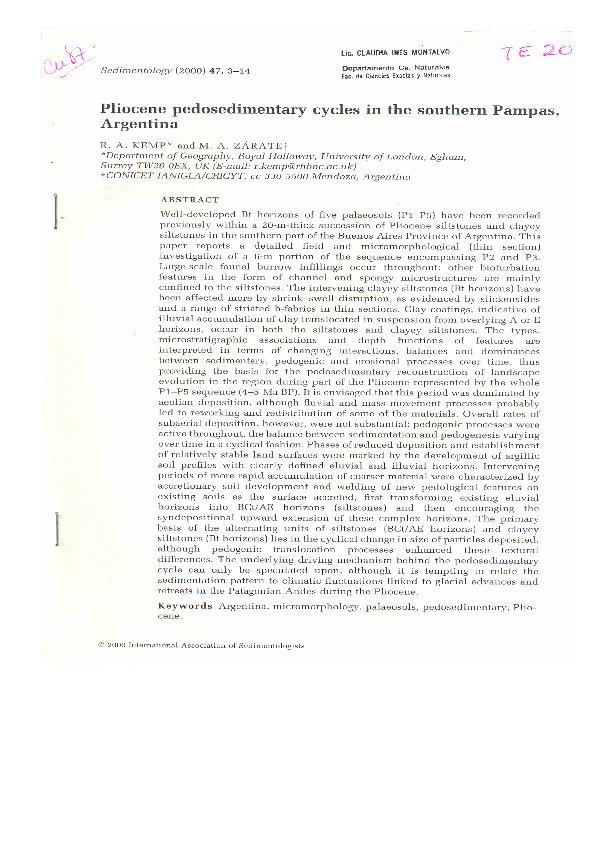Mostrar el registro sencillo del ítem
dc.contributor.author
Kemp, R. A.
dc.contributor.author
Zárate, Marcelo Arístides

dc.date.available
2019-03-15T21:27:17Z
dc.date.issued
2000-02
dc.identifier.citation
Kemp, R. A.; Zárate, Marcelo Arístides; Pliocene pedosedimentary cycles in the southern Pampas, Argentina; Wiley Blackwell Publishing, Inc; Sedimentology; 47; 1; 2-2000; 3-14
dc.identifier.issn
0037-0746
dc.identifier.uri
http://hdl.handle.net/11336/71801
dc.description.abstract
Well-developed Bt horizons of five palaeosols (P1-P5) have been recorded previously within a 20-m-thick succession of Pliocene siltstones and clayey siltstones in the southern part of the Buenos Aires Province of Argentina. This paper reports a detailed field and micromorphological (thin section) investigation of a 6-m portion of the sequence encompassing P2 and P3. Large-scale faunal burrow infillings occur throughout: other bioturbation features in the form of channel and spongy microstructures are mainly confined to the siltstones. The intervening clayey siltstones (Bt horizons) have been affected more by shrink-swell disruption, as evidenced by slickensides and a range of striated b-fabrics in thin sections. Clay coatings, indicative of illuvial accumulation of clay translocated in suspension from overlying A or E horizons, occur in both the siltstones and clayey siltstones. The types, microstratigraphic associations and depth functions of features are interpreted in terms of changing interactions, balances and dominances between sedimentary, pedogenic and erosional processes over time, thus providing the basis for the pedosedimentary reconstruction of landscape evolution in the region during part of the Pliocene represented by the whole P1-P5 sequence (4-5 Ma BP). It is envisaged that this period was dominated by aeolian deposition, although fluvial and mass movement processes probably led to reworking and redistribution of some of the materials. Overall rates of subaerial deposition, however, were not substantial: pedogenic processes were active throughout, the balance between sedimentation and pedogenesis varying over time in a cyclical fashion. Phases of reduced deposition and establishment of relatively stable land surfaces were marked by the development of argillic soil profiles with clearly defined eluvial and illuvial horizons. Intervening periods of more rapid accumulation of coarser material were characterized by accretionary soil development and welding of new pedological features on existing soils as the surface accreted, first transforming existing eluvial horizons into BCt/AE horizons (siltstones) and then encouraging the syndepositional upward extension of these complex horizons. The primary basis of the alternating units of siltstones (BCt/AE horizons) and clayey siltstones (Bt horizons) lies in the cyclical change in size of particles deposited, although pedogenic translocation processes enhanced these textural differences. The underlying driving mechanism behind the pedosedimentary cycle can only be speculated upon, although it is tempting to relate the sedimentation pattern to climatic fluctuations linked to glacial advances and retreats in the Patagonian Andes during the Pliocene.
dc.format
application/pdf
dc.language.iso
eng
dc.publisher
Wiley Blackwell Publishing, Inc

dc.rights
info:eu-repo/semantics/openAccess
dc.rights.uri
https://creativecommons.org/licenses/by-nc-sa/2.5/ar/
dc.subject
Argentina
dc.subject
Micromorphology
dc.subject
Palaeosols
dc.subject
Pedosedimentary
dc.subject
Pliocene
dc.subject.classification
Otras Ciencias de la Tierra y relacionadas con el Medio Ambiente

dc.subject.classification
Ciencias de la Tierra y relacionadas con el Medio Ambiente

dc.subject.classification
CIENCIAS NATURALES Y EXACTAS

dc.title
Pliocene pedosedimentary cycles in the southern Pampas, Argentina
dc.type
info:eu-repo/semantics/article
dc.type
info:ar-repo/semantics/artículo
dc.type
info:eu-repo/semantics/publishedVersion
dc.date.updated
2019-03-14T14:11:17Z
dc.journal.volume
47
dc.journal.number
1
dc.journal.pagination
3-14
dc.journal.pais
Reino Unido

dc.journal.ciudad
Londres
dc.description.fil
Fil: Kemp, R. A.. University of London; Reino Unido
dc.description.fil
Fil: Zárate, Marcelo Arístides. Consejo Nacional de Investigaciones Científicas y Técnicas. Centro Científico Tecnológico Conicet - Mendoza. Instituto Argentino de Nivología, Glaciología y Ciencias Ambientales. Provincia de Mendoza. Instituto Argentino de Nivología, Glaciología y Ciencias Ambientales. Universidad Nacional de Cuyo. Instituto Argentino de Nivología, Glaciología y Ciencias Ambientales; Argentina
dc.journal.title
Sedimentology

dc.relation.alternativeid
info:eu-repo/semantics/altIdentifier/url/https://onlinelibrary.wiley.com/doi/abs/10.1046/j.1365-3091.2000.00274.x
dc.relation.alternativeid
info:eu-repo/semantics/altIdentifier/doi/http://dx.doi.org/10.1046/j.1365-3091.2000.00274.x
Archivos asociados
